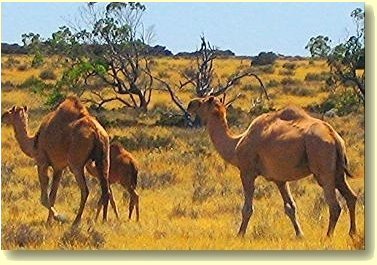 The Australian Camel
The Australian Camel They were really brought in to open up this great land of ours and certainly opened up this country all right and I did hear they were at one time exported to the Middle East and other countries that have a tradition of using this humble beast which to me has always seemed a proud and haughty animal and not at all humble.
Camel trains in the beginning they linked South Australia to Alice Springs in the northern Territory.
There is a rail link now of course and just recently it was extended from the Alice all the way up to Darwin the Capital of the NT; called the Ghan just a shortened version of Afghan Camel Train.
My daughter travelled on it a few years ago on her way to Darwin; of course she had to drive from the Alice on up to Darwin then, car was with her on the train of course which she caught at Melbourne.
I can’t picture her on a Camel somehow lol.
Many different types and breeds of camels were brought into Australia. They included the large fleece bearing two humped Bactrian camel of China/Mongolia, elite Bishari and Bikaneri riding camels of Arabia to the powerful freight carrying lowland Indian camels which were capable of carrying huge loads of up to 800kg. The modern Australian camel is a meld of these types.
I myself have seen them on the beaches of Eastern Queensland giving rides mainly to children.
Smelly beasts but to me a proud looking animal With the advent of rail and motor transport they became uneconomical and were released into the wild.
 The harsh environment suited the camels and they bred prolifically. Camel numbers in Australia have been estimated at 200,000 with approximately half of them in Western Australia.
The harsh environment suited the camels and they bred prolifically. Camel numbers in Australia have been estimated at 200,000 with approximately half of them in Western Australia.
 What was that then Mom? oh yeah them Camels from the Olgas.
Camels have the potential to produce low cholesterol milk, meat and, in temperate zones, a luxury fibre similar to cashmere.
What was that then Mom? oh yeah them Camels from the Olgas.
Camels have the potential to produce low cholesterol milk, meat and, in temperate zones, a luxury fibre similar to cashmere. So I read in a book on the subject. Camels are easy to manage and require similar fencing to cattle, although yards and handling facilities may need modification to allow for the size of camels. There are an estimated 200,000 feral camels in Australia. They are found in the arid areas of Central Australia, Western Australia and South Australia, but domesticated camels can adapt to the environmental conditions in all regions of Australia. Camels are browsers rather than grazers, preferring roughage to improved pasture.











No comments:
Post a Comment